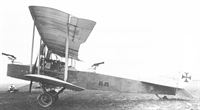
| Самолеты (сортировка по:) | |||||
| Страна | Конструктор | Название | Год | Фото | Текст |
Hansa-Brandenburg ZM / ZM II / GF

|
Страна: Германия Год: 1915
|
| Hansa-Brandenburg - NW / GNW - 1915 - Германия | <– | –> | Hansa-Brandenburg - CC - 1916 - Германия |
 |
C.Owers - Hansa-Brandenburg Aircraft of WWI. Volume 1 - Landplanes /Centennial Perspective/ (17) |
| This machine has been identified as the Type ZM. The ailerons are mounted between the wings on the interplane struts and theses struts are vertical. The radiators are mounted alongside the engines and the nose has twin wheels mounted under the bow cockpit. A single fin and rudder is fitted. This machine corresponds with the Brandenburg factory three-view plan of the ZM. According to Grosz, P.; Haddow, G. & Schiemer, P. (Austro-Hungarian Army Aircraft of World War One, P.414.) the ZM had the characteristic Brandenburg inward-sloping interplane struts and triple rudders to give control in case of an engine out. |
 |
Форум - Breguet's Aircraft Challenge /WWW/ |
 |
C.Owers - Hansa-Brandenburg Aircraft of WWI. Volume 1 - Landplanes /Centennial Perspective/ (17) |
| Brandenburg chief designer Ernst Heinkel flanked by Flars officers poses with the 05.05 battleplane on the occasion of its roll-out in late summer 1915. The inward-sloping interplane struts are clearly seen, radiators are mounted above the engines, and there are no wheels under the nose gunner's position. The inward-slanting struts were intended to keep the bending moments of the top and bottom spars equal. |
 |
Форум - Breguet's Aircraft Challenge /WWW/ |
| ZM II or Hansa Brandenburg Type GF, developed from the Type ZM originally built for the German Navy. The machine got the Austro-hungarian registration 05.05. |
 |
E.Hauke, W.Schroeder, B.Totschinger - Die Flugzeuge der k.u.k. Luftfahrtruppe und Seeflieger 1914-1918 |
| Brandenburg ZM, Flugzeugnummer 05.05 |
 |
C.Owers - Hansa-Brandenburg Aircraft of WWI. Volume 1 - Landplanes /Centennial Perspective/ (17) |
| A poor photograph but one that shows the triple rudders of 05.05. |
 |
C.Owers - Hansa-Brandenburg Aircraft of WWI. Volume 1 - Landplanes /Centennial Perspective/ (17) |
| 05.05 before being fitted with bomb racks. |
 |
P.Grosz, G.Haddow, P.Shiemer - Austro-Hungarian Army Aircraft of World War One /Flying Machines/ |
| Photographed at Flik 19, the 05.05 prototype shows the excellent field of fire provided by the raised machine-gun positions. A Fokker fighter, series 03, is in the background. (This photograph was printed on pebble-texture paper which accounts for the loss of detail). (AHT AL0579-063) |
 |
C.Owers - Hansa-Brandenburg Aircraft of WWI. Volume 1 - Landplanes /Centennial Perspective/ (17) |
| After repair and being fitted with bomb racks, the 05.05 was assigned to Flik 19 in March. It was totally demolished in a landing accident on 6 April 1916 while returning from a raid on Chiopris. |
 |
C.Owers - Hansa-Brandenburg Aircraft of WWI. Volume 1 - Landplanes /Centennial Perspective/ (17) |
| 05.05, identified by the lack of the additional undercarriage wheels under the nose, in flight. For its day it was a promising weight lifter and was to lead towards the GF bomber. |
 |
P.Grosz, G.Haddow, P.Shiemer - Austro-Hungarian Army Aircraft of World War One /Flying Machines/ |
| Hansa-Brandenburg factory in Briest in late 1915. To the left of the administration building can be seen a Brandenburg FD, and to the right the Types DD, LDD, and GF. |
 |
C.Owers - Hansa-Brandenburg Aircraft of WWI. Volume 1 - Landplanes /Centennial Perspective/ (17) |
| The three-man crew carried by the 05.05 comprised a front gunner, seated between the wings for take-off and landing, and a rear gunner who shared the pilot’s cockpit behind the center section struts, a position that severely limited the pilot’s visibility. The mounting rails for the fore and aft machine guns are prominent. |
 |
C.Owers - Hansa-Brandenburg Aircraft of WWI. Volume 1 - Landplanes /Centennial Perspective/ (17) |
| Brandenburg Type ZM Factory Drawing |